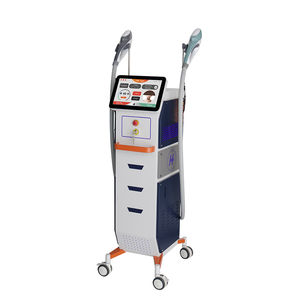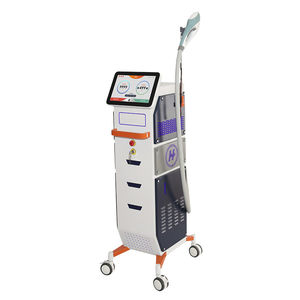
- Secondary care
- Dermatology
- Hair removal DPL system
- Beijing VCA Laser
- Company
- Products
- Catalogs
- News & Trends
- Exhibitions
Hair removal DPL system VCL3 trolley-mounted

Add to favorites
Compare this product
Characteristics
- Application
- hair removal
- Ergonomics
- trolley-mounted
- Wavelength
Min.: 530 nm
Max.: 950 nm
Description
The theoretical basis of cell phototherapy for skin diseases is the principle of selective photo thermal action. By heating the water molecules in the skin through a specific spectrum (selective), the thermal energy stimulates fibroblasts in the superficial and middle layers of the dermis, and induces the activation of the skin's self-healing muscle mass, thereby regenerating collagen, tightening the skin, and shrinking pores.
The theoretical basis of cell phototherapy for skin diseases is the principle of selective photo thermal action. By heating the water molecules in the skin through a specific spectrum (selective), the thermal energy stimulates fibroblasts in the superficial and middle layers of the dermis, and induces the activation of the skin's self-healing muscle mass, thereby regenerating collagen, tightening the skin, and shrinking pores.
The massive regeneration of dermal collagen will cause a part of collagen and aging cells to be metabolized to the epidermis, and enough metabolites received by the epidermis will also be absorbed as nutrients, thereby increasing the stratum corneum, repairing damaged cells, and improving sensitive skin.
VIDEO
Catalogs
Hair removal DPL system VCL3
10 Pages
Related Searches
- Aesthetic medicine laser
- Trolley-mounted laser
- Tabletop laser
- Nd:YAG laser
- Dermatology laser
- Skin rejuvenation laser
- Millisecond laser
- Surgical laser
- Tattoo removal laser
- Class 4 laser
- CO2 laser
- Pigmented lesion treatment laser
- IPL system
- Hair removal IPL system
- Acne treatment laser
- Picosecond laser
- Skin rejuvenation IPL system
- Vascular lesion treatment laser
- Scar removal laser
- Trolley-mounted IPL system
*Prices are pre-tax. They exclude delivery charges and customs duties and do not include additional charges for installation or activation options. Prices are indicative only and may vary by country, with changes to the cost of raw materials and exchange rates.








